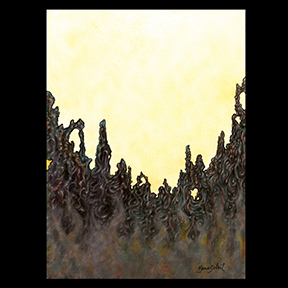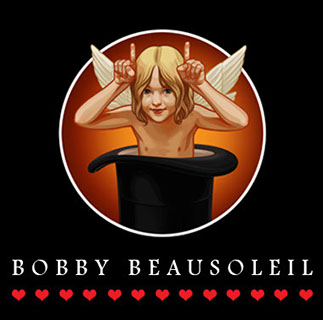
Manifesto of an Artist in Prison
Bobby BeauSoleil
W very so often I have come under fire for the path I've chosen around expressing in the creative arts and publishing my work through an online presence. There are people, perhaps well-intentioned, who are adamant in their stance that prison is for punishment, and that people who are doing time for a crime should not be permitted to engage in activities that do not strictly conform to this narrow definition. Since my ability to produce and publish my work in a reasonably meaningful way are occasionally influenced by controversies of this sort, I am taking this opportunity to address the issues head-on and describe what drives the kinds of activities that sometimes put me in the line of fire.
very so often I have come under fire for the path I've chosen around expressing in the creative arts and publishing my work through an online presence. There are people, perhaps well-intentioned, who are adamant in their stance that prison is for punishment, and that people who are doing time for a crime should not be permitted to engage in activities that do not strictly conform to this narrow definition. Since my ability to produce and publish my work in a reasonably meaningful way are occasionally influenced by controversies of this sort, I am taking this opportunity to address the issues head-on and describe what drives the kinds of activities that sometimes put me in the line of fire.
To be absolutely clear, I disagree with the proposition that imprisonment for a crime should be all about unremitting punishment and perpetual condemnation. The notion that prisons should be a living Hell where people who have committed bad crimes are made to suffer and suffer and suffer has the potential to turn the entire world into a living Hell. Such an approach to criminal justice takes people who have made bad mistakes and turns them into monsters — monsters who may one day be released from prison to wreak havoc in the communities they had formerly lived as citizens.
I was once, long ago, on my way to turning myself into one of those monsters. I had been sent to prison for a horrible crime I had committed against another human being, and then, for lack of being able to see any alternative, I continued along the same trajectory that had led to my imprisonment — desperately trying to find acceptance among the hard-cases that I was living among, trying to fit in by emulating their tough guy posturing, and gradually adopting their bitter philosophies and falling in with their violent lifestyle. Just as I was on the verge of losing myself in that world forever my guardian angel grabbed me by the collar and pulled me back from the edge of the abyss. There's no better way to describe the sudden shift in my consciousness when it came. I woke up, just like that.
This was in 1974, not long after I had been caught up in a battle between warring prison gangs on the lower yard at San Quentin. I was in the prison infirmary where I was being treated for bone fractures in several parts of my body. Suddenly it dawned on me that the men I had been trying to be like were behaving like hard-cases because they were just as frightened on the inside as I was. Suddenly it became clear that the only person I needed to prove myself to was me; that the only man whose respect I needed to earn was the one I saw reflected in the mirror.
That day I made a promise to myself, a personal vow: From that moment on I would never again intentionally initiate a violent act against another human being and, furthermore, that I would rechannel any destructive or self-destructive tendencies through creative self-expression in aesthetic endeavor.
On its face such a vow is almost childlike in its simplicity: destructiveness bad; creativity good. At the time all I was looking for was a way forward, and in that regard it served well enough. Over time, as I matured and became gradually more grounded in a spiritual identity and philosophy, I would learn that the first part of my vow is a very old tradition called ahimsa, the yoga of non-violence, one of the limbs of Sri Patanjali’s yoga system. In this context non-violence does not mean passivity. Active non-violence is implacable, and that makes it quite a powerful practice. Essentially the practice of ahimsa is conscious reverence for the Divine Light who abides within all beings. The other part of my vow, to devote my life to creative expression in the arts, has roots in the precept of dharma, or purpose in life. Dharma implies that every person is endowed with a gift (or set of gifts) at birth, and that every person has a responsibility to share their gift with the world, to do one’s part to bring sentience to the physical universe. Clearly, since I was innately gifted with some artistic talents, my vow to devote my life to expressing them is the path I was meant to be on.
Finding one's way to redemption in the modern world is no easy task. The greater the wrongs one has done the more difficult that task becomes. Back in the early 1970s when I was so very much in need of a pathway to redemption, I felt lost in some dark wilderness, and I couldn't find anyone who could show me the way back to where there was light. People would use words like 'rehabilitation' but no one in the place where I was could describe what that might actually look like. I was on my own. In a place where every direction I looked appeared hopeless I turned to the only remaining possibility: I looked inside myself. There I found one little ray of light, and so I nursed it until it flared up enough to carry me forward.
The role of every artist is to bring some light to the world. To be sure, I've done an imperfect job of it. Being human is all about trial and error, stumbling and falling and getting back up, and figuring out what works. Because I had deprived the world of what gifts Gary Hinman may have brought to it in the fullness of his life, I felt the need to redouble my efforts and to try to do more than I might have otherwise, in the hope that I might make up for that a little bit. In the end, I am not the one to say how successful I may have been in this mission I've been on these past 40-plus years. What I can claim with confidence is having given it a solid effort.
You might ask: If publishing my work has become a threat to my wellbeing and the potential of my being released from prison at some point, why keep doing that? The answer is simple: Because I must. I made a promise, and the result of keeping that promise has, so far, literally been my saving Grace. Expressing in the creative arts is a form of worship. Sharing it with everyone who may find something to appreciate in it is also a form of worship. It would seem that the wisest course is to keep the faith and see it through.
Way back in 1972 I was given a second chance to make something good of myself when the death sentence I had been given by the jury that convicted me was commuted to life imprisonment with possibility of parole after seven years. You don’t have to look very far to see that I have made every effort to demonstrate that I was worthy of the generous opportunity I had been granted.
While my dedication to expressing in the arts has been a valuable tool in my personal transformative process, of restoring myself to integrity out of the scattered wreckage of my past, the artifacts that have come out of that are not the measure of who I am. The most these things may serve to indicate is that I have not allowed prison to define me, nor a crime, or past affiliation with someone notorious, or a list of accomplishments achieved in spite of one's handicaps or weaknesses; not the failings nor even the successes. What defines a man, it seems to me, is how he plays all the cards he is dealt. This is the true service. In the end it is transcendence that matters.
Bobby BeauSoleil
November 13th, 2016
© 2014 Bobby BeauSoleil and BHDesigns. All Rights Reserved. Images are copyrighted to their respective owners. Go to our Privacy Policy.
